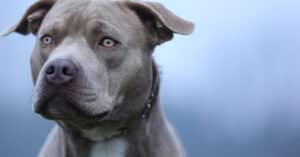Dogs, canines, and man’s best friends. We have several nicknames for dogs. No matter how you refer to them, you certainly love these four-legged and fur-clad creatures. Whether it’s here in our modern era or hundreds of centuries past, it has been proven just how loyal and compassionate dogs can be. But where do these furry friends come from? In this article, we’ll go through the ins and outs of dog reproduction.
As a dog owner, it’s important to understand all of the intricacies that come with the reproductive behavior of your canine. From the beginning phases of flirtation and courtship to the moment their little puppies open their eyes, you won’t miss out on a single step along the way!
Dog Courtship

Scent marking is a way that dogs display to others that they are ready to engage in courtship.
©Marek Rybar/Shutterstock.com
You might prefer an evening on the town completed by a fancy moonlit dinner to be the best route of courtship. However, that isn’t exactly how the process works in the realm of dog reproduction. Unimpressed by fancy things like roses and jewelry, there are a few (much more biological) factors that dogs take into account before mating.
The first thing that dogs notice immediately when deciding to court is whether or not the female dog is in estrus. This is the formal name for a female dog’s heat, which will be discussed in depth later in the article. Scent marking is another way that dogs advertise their availability. When females are in heat, they excrete pheromones alerting nearby males that she’s ready to rumble. Males have quite the nose for this and can easily identify females in heat.
There are three primary physical behaviors that dogs display when courting:
- Flagging: When a female is in heat, she might raise or move her tail in a way that exposes her vulva.
- Mounting: A common behavior that you may have seen your own dog display in the past. Mounting is a display of dominance at its core, but it is often conducted in a sexual context.
- Play: Who wants to hook up with someone who they think is no fun? Much like in many other animals, playful behavior is an important part of the courtship ritual. Sometimes it’s just things like chasing, but don’t be surprised when some nipping becomes involved.
Potential Courting Issues
Not ones to quit, male dogs can be quite persistent when it comes to mating. If they can sense that a female is in heat, the male dog won’t hesitate to chase her down until she finally accepts his advances. Not very gentleman-like, but our furry friends can get away with it. Of course, there are times that a female will indicate that she simply isn’t interested with enough ferocity for the male to get the hint.
Another male courting trait, not dissimilar to human men, is competitiveness. If multiple males are interested in a single female, there can be trouble that arises. Expect aggression, and especially watch out for the possibility of a fight.
Dog Mating and Conception
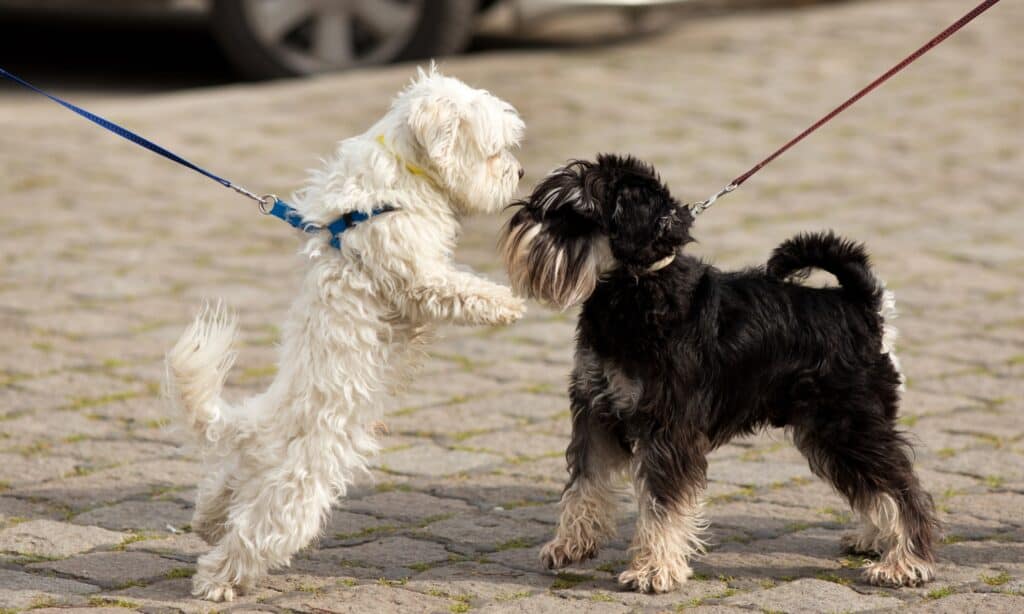
A female dog’s ova (eggs) will only become fertilized if she is ovulating.
©iStock.com/Jevtic
Once two dogs have both displayed interest in mating, the dog reproduction process is fully underway. When two dogs begin mating, the conception is done through a process called a “tie” or “lock”. This happens when the male dog’s bulbous glands begin to swell once inside the female dog. The tie varies in length but can last anywhere between five short minutes to over half an hour. When the tie has been broken, it’s because the male has ejaculated.
The frequency of mating depends, varying between every dog. Some breeders may allow their dogs to mate multiple times in a relatively short span to ensure that conception is reached. This conception happens when the male’s sperm travels up the female’s reproductive tract. If the female is ovulating, fertilization of the ova (eggs) can take place. These fertilized eggs begin their journey into the uterus. In roughly a week, these eggs will develop into blastocysts, implanting themselves into the uterus lining. This is where those eggs develop into embryos and, eventually, puppies!
Canines in Heat
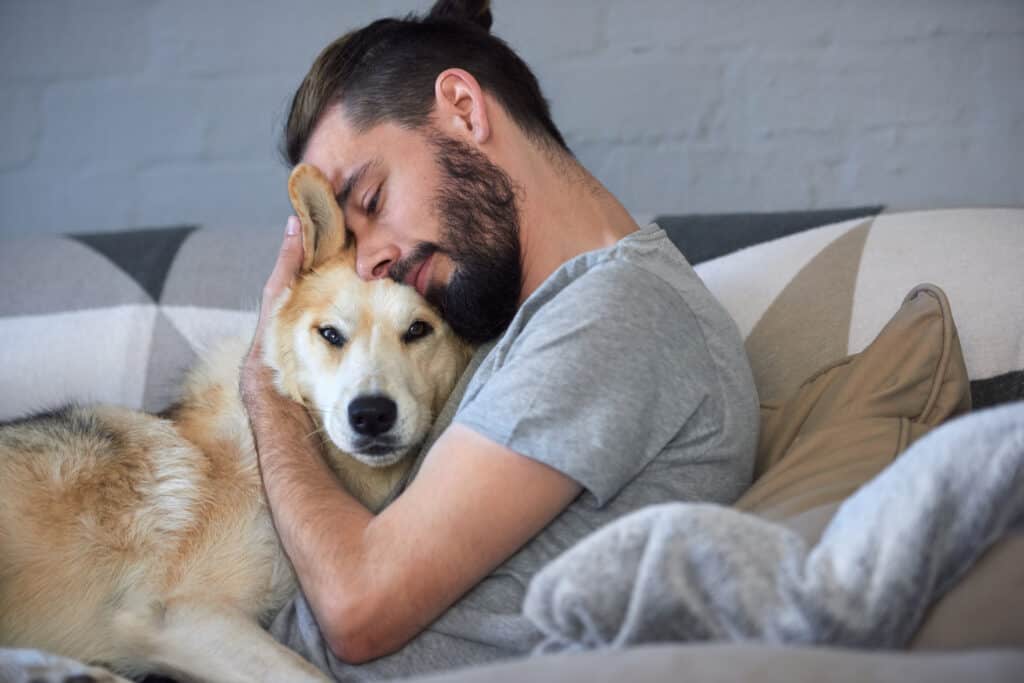
Estrus, or a dog’s heat cycle, contains four phases.
©Daxiao Productions/Shutterstock.com
In total, there are four phases within your female dog’s estrus (heat) cycle. Here is a rough timeline for how frequent and long-lasting these phases are:
Proestrus
This phase is the first of the four, typically lasting from seven to ten days. When the proestrus phase is in its full swing, there will be swelling of the vulva that is accompanied by bloody discharge and increased urination. During this phase, there are a few behavior changes as well. Your dog might act more clingy and moody than usual. Plus, even though males will be attracted to her during this phase, chances are she’ll be less than interested.
Estrus
The next phase, estrus, also lasts for seven to ten days. This is the most commonly thought of phase when one hears “heat,” as the female begins to experience bloody discharge ranging from bloody to straw-colored. In this period, your female dog will be much more receptive to mating. She might even flag her tail when a male approaches.
Diestrus
In Diestrus, which lasts two to three months, the vulva returns to normal. There is no more discharge, and you’ll notice that she will display minimal interest in mating. Regardless of whether or not the dog has become pregnant, this phase will have the same duration.
Anestrus
Last but certainly not least is Anestrus. This phase has effectively no sexual activity, and your female dog should be behaving normally. This is the period of inactivity between the cycles, lasting about three months each time it rolls around.
Caring For A Dog In Heat
It can be hard seeing your dog in heat because there are a number of hormonal changes that they are actively experiencing. This pain might not be akin to menstruating human women, but there is still a level of discomfort during this part of dog reproduction. Every dog is different, so while some may become restless and irritable during heat, others might become increasingly affectionate.
Something that you can do to assist their heat symptoms is to keep an eye on their hygiene. Perhaps invest in special dog diapers or pads if your dog is kept mostly indoors. You could also consider fixing your dog if there is no intention to breed. Alongside reducing the likelihood that you wind up with unwanted puppies, you can also grant your dog health benefits that reduce their risk of certain cancers and other illnesses.
Dog Pregnancy
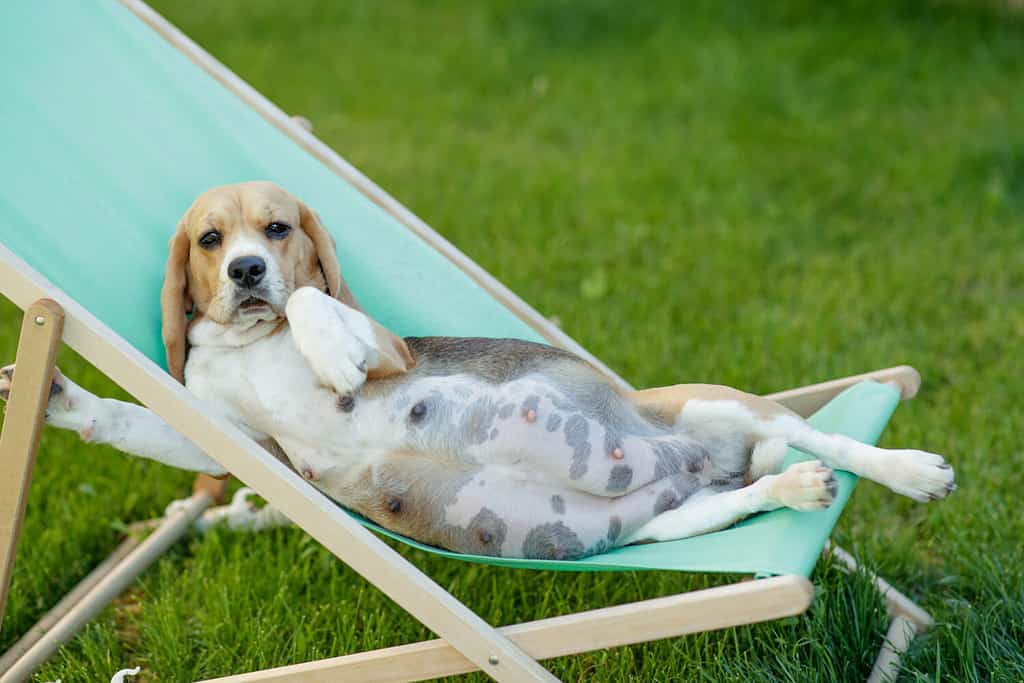
The average dog gestation period is between 57-65 days.
©Nina Buday/Shutterstock.com
The most beautiful and exciting part of dog reproduction is pregnancy. It’s a critical phase in their life cycle, so understanding it is very important. The average gestation period for dogs falls between 57 and 65 days. This can vary depending on multiple factors, like breed and age.
Caring for your dog during its pregnancy isn’t as complex as it might seem. Ensure that a balanced and nutritional diet is being given to the pregnant dog, as well as limiting any play that might be too strenuous for the babies. While you don’t want the mother to become overly exerted, you should still make sure she’s getting a fair amount of exercise! Try to limit causes of stress in her environment to keep her as happy and comfortable as possible.
Sooner than you might think, it will be time for labor. Some signs to look out for before the labor begins are pacing, a loss of appetite, and increased amounts of restlessness. In addition, her body temperature might drop slightly. If you notice that the labor has been induced quite early, or if your dog remains pregnant past the typical gestation period, it is wise to take them to the vet to be evaluated.
Signs A Dog May Be Pregnant
If you’re unsure about your dog’s pregnancy, but have your suspicions, here are some specific signs to look out for. While these are all strong indicators, also keep in mind that a visit to the vet is the only certain way to determine if your dog is pregnant.
- Behavioral Changes: When your dog becomes pregnant, you might notice that they’re acting differently. These kinds of behavioral changes are different from dog to dog. Some might begin to act overly cuddly and affectionate, while others could begin to withdraw or grow less social.
- Appetite: Different changes in appetite will become apparent at different phases of the pregnancy. Toward the beginning, your dog might eat less. But, their appetite will increase as the pregnancy moves along.
- Weight Gain: Around the fourth week of the dog’s pregnancy, her belly will become rounded. Weight gain begins to become evident as the pregnancy progresses and will depend on the number of puppies in the incoming litter.
The Birth of Dogs
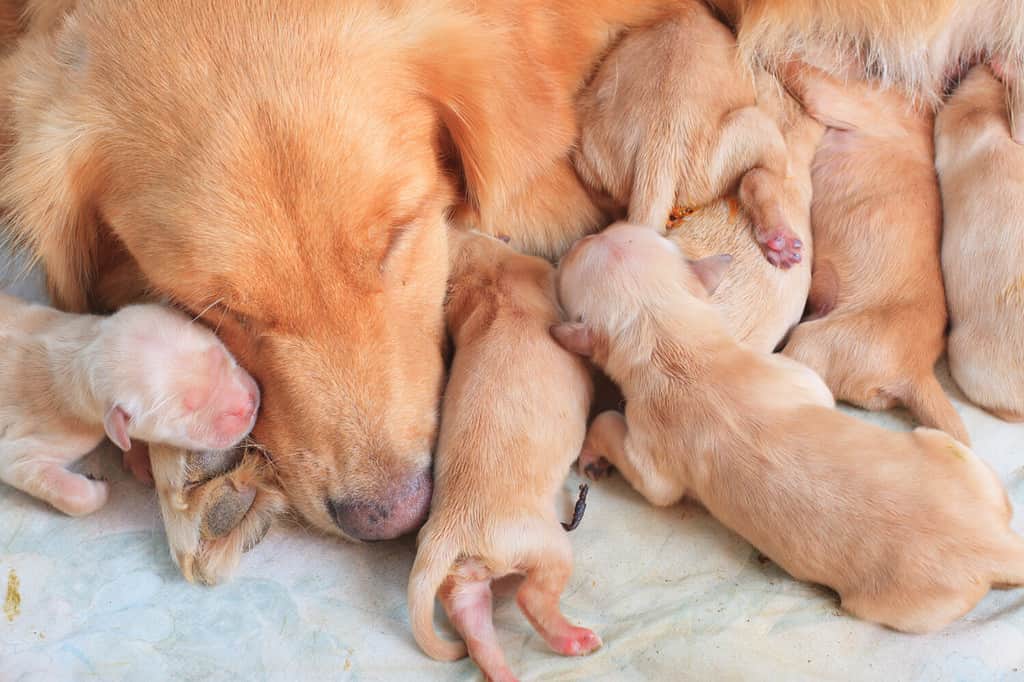
When the mother gives birth, there can be pauses of up to an hour between the birth of each puppy in the litter.
©stockphoto mania/Shutterstock.com
There are a few telltale signs that a litter of puppies, the end of the dog reproduction journey, is on the way. Something that many female dogs do is called nesting, which is when they seek a quiet and cozy location in the home to deliver. You can assist your dog in nesting by adding some comfortable blankets or a few of their favorite toys to the pile. Don’t be too hands-on, however, as you want to let the momma have her required space.
Labor for dogs is particularly interesting because there are almost always multiple puppies in a litter. Litters range between one and twelve puppies at once, but the average is between five and six. Contractions push these puppies through the birth canal one at a time, but the trouble is, there are rest periods in between these births. Since the pauses can last up to an hour per puppy, the labor process could take nearly an entire day to completely finish.
Expect the mother dog to be quite exhausted following the birth. Keep a close eye on her during this time. She’ll usually begin licking her puppies in an attempt to stimulate their breathing. Don’t be alarmed if you see some teeth, either. Mother dogs will bite off the puppies’ umbilical cords and sometimes may even eat the placenta. Researchers believe they do this because the placenta is rich in nutrients. That, and the mother dog may simply want to clean up her birthing area. With the puppies safely delivered, the dog reproduction cycle has come to a close.
The photo featured at the top of this post is © Chalabala/ via Getty Images
Ready to discover the top 10 cutest dog breeds in the entire world?
How about the fastest dogs, the largest dogs and those that are -- quite frankly -- just the kindest dogs on the planet? Each day, AZ Animals sends out lists just like this to our thousands of email subscribers. And the best part? It's FREE. Join today by entering your email below.
Thank you for reading! Have some feedback for us? Contact the AZ Animals editorial team.





